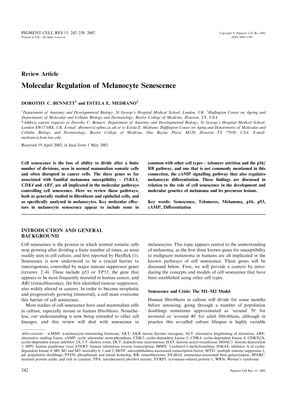Molecular Regulation of Melanocyte Senescence
July 2002
in “
Pigment Cell Research
”

TLDR The article concludes that while we understand a lot about how melanocytes age and how this can prevent cancer, there are still unanswered questions about certain pathways and genes involved.
The 2002 review article examined the molecular mechanisms behind melanocyte senescence and its connection to melanoma development. It emphasized the importance of cell senescence as a barrier to cancer and the role of tumor suppressor genes like p53 and RB1. The review detailed how familial melanoma susceptibility genes INK4A, CDK4, and ARF are involved in senescence pathways, and it introduced the cAMP signaling pathway's role in melanocyte differentiation. The study found that culture media components affect melanocyte lifespan and differentiation, with cAMP agonists leading to a lifespan of 8 to 45 population doublings for neonatal melanocytes, while media with TPA extended lifespan to 40-60 population doublings. Melanocytes from older donors proliferated less and had a shorter lifespan, with Negroid melanocytes having a shorter lifespan than Caucasian melanocytes in some media. Gene expression changes during senescence were observed, including the down-regulation of cyclin E and up-regulation of p16INK4a. The p16/RB1 pathway was identified as crucial for melanocyte senescence, with the p53 pathway acting as a backup. The extension of melanocyte lifespan was possible through HPV oncogenes or hTERT expression, though not indefinitely. The review concluded that while much is known about melanocyte senescence, questions remain regarding the cAMP pathway's impact on lifespan and the potential role of p300 and CBP in chromatin remodeling related to senescence and cancer.



